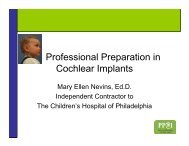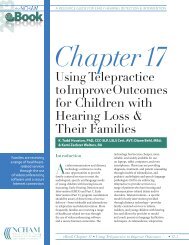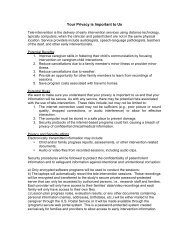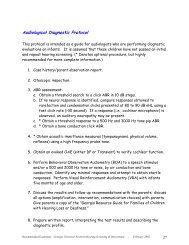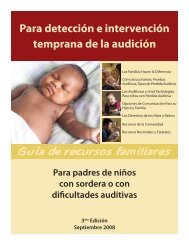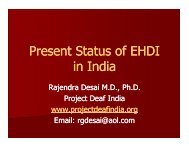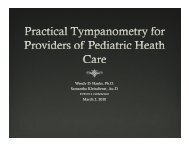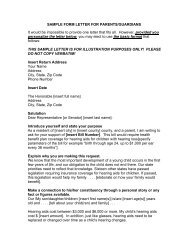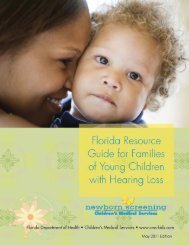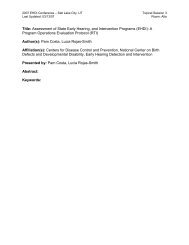The Prevalence of ADHD and LD in Children with Hearing Loss The ...
The Prevalence of ADHD and LD in Children with Hearing Loss The ...
The Prevalence of ADHD and LD in Children with Hearing Loss The ...
Create successful ePaper yourself
Turn your PDF publications into a flip-book with our unique Google optimized e-Paper software.
<strong>The</strong> <strong>Prevalence</strong> <strong>of</strong> <strong>ADHD</strong> <strong>and</strong> <strong>LD</strong> <strong>in</strong><strong>Children</strong> <strong>with</strong> Hear<strong>in</strong>g <strong>Loss</strong>Krista R. Biernath MD, Susanna N. Visser PhD, W. June Holstrum PhDCenters for Disease Control <strong>and</strong> PreventionNational Center on Birth Defects<strong>and</strong> Developmental DisabilitiesTM
<strong>ADHD</strong> <strong>and</strong> <strong>LD</strong> <strong>in</strong> School-Aged <strong>Children</strong><strong>with</strong> Hear<strong>in</strong>g <strong>Loss</strong>• <strong>The</strong>re are approximately 54 million school-aged children <strong>in</strong> the US• <strong>ADHD</strong> <strong>and</strong>/or <strong>LD</strong> affect approximately 10% <strong>of</strong> these children• An estimated 10-15% <strong>of</strong> all school-aged children have some type<strong>of</strong> hear<strong>in</strong>g loss– Congenital– Progressive– Mild <strong>and</strong> unilateral– Fluctuat<strong>in</strong>g conductive losses due to OME– Noise <strong>in</strong>duced• <strong>The</strong> number <strong>of</strong> children <strong>with</strong> hear<strong>in</strong>g loss who also have <strong>ADHD</strong> or<strong>LD</strong> is unknownTM
Diagnostic Criteria <strong>of</strong> <strong>ADHD</strong>Diagnostic <strong>and</strong> Statistical Manual <strong>of</strong> Mental Disorders (DSM-IV-TR)• 6 or more symptoms <strong>of</strong> a list <strong>of</strong> <strong>in</strong>attentive behaviors OR• 6 or more symptoms <strong>of</strong> a list <strong>of</strong> hyperactivity / impulsivity behaviors• <strong>The</strong>se behaviors have been present for at least 6 months to a po<strong>in</strong>tthat is disruptive <strong>and</strong> <strong>in</strong>appropriate for developmental level• Hear<strong>in</strong>g loss is not excludedSeveral <strong>of</strong> the behaviors could easily be confused <strong>with</strong> signs <strong>of</strong> hear<strong>in</strong>g lossTM
Diagnostic Criteria <strong>of</strong> Learn<strong>in</strong>g DisabilityDiagnostic <strong>and</strong> Statistical Manual <strong>of</strong> Mental Disorders (DSM-IV-TR)• A Learn<strong>in</strong>g Disorder (<strong>LD</strong>) is diagnosed when a child’s achievementon <strong>in</strong>dividually adm<strong>in</strong>istered st<strong>and</strong>ardized tests <strong>in</strong> read<strong>in</strong>g,mathematics, or written expression is substantially below thatexpected for age, school<strong>in</strong>g, <strong>and</strong> level <strong>of</strong> <strong>in</strong>telligence– Substantially below is usually def<strong>in</strong>ed as a discrepancy <strong>of</strong> morethan 2 st<strong>and</strong>ard deviations between achievement <strong>and</strong> IQ.• <strong>The</strong> learn<strong>in</strong>g problems significantly <strong>in</strong>terfere <strong>with</strong> academicachievement or activities <strong>of</strong> daily liv<strong>in</strong>g that require the skillsTM
Diagnostic Criteria <strong>of</strong> Learn<strong>in</strong>g Disability<strong>The</strong> 2004 amendments to the Individuals <strong>with</strong> Disabilities Education Act(IDEA)• A disorder <strong>in</strong> 1 or more <strong>of</strong> the basic psychological processes<strong>in</strong>volved <strong>in</strong> underst<strong>and</strong><strong>in</strong>g or <strong>in</strong> us<strong>in</strong>g language, spoken or written,which disorder may manifest itself <strong>in</strong> imperfect ability to listen,th<strong>in</strong>k, speak, read, write, spell, or do mathematical calculations• Such term <strong>in</strong>cludes such conditions as perceptual disabilities, bra<strong>in</strong><strong>in</strong>jury, m<strong>in</strong>imal bra<strong>in</strong> dysfunction, dyslexia <strong>and</strong> developmentalaphasia• Such term does not <strong>in</strong>clude a learn<strong>in</strong>g problem that is primarily theresult <strong>of</strong> visual, hear<strong>in</strong>g, or motor disabilities, or mentalretardation, <strong>of</strong> emotional disturbance, or <strong>of</strong> environmental, cultural,or economic disadvantageTM
National Health <strong>and</strong> NutritionExam<strong>in</strong>ation Survey (NHANES)• Nationally representative sample• Interviews <strong>and</strong> physical exam<strong>in</strong>ations – <strong>in</strong>clud<strong>in</strong>g audiologicalexam<strong>in</strong>ation• Very small sample size: approximately 5000 total sample size(adults <strong>and</strong> children) per year• Conducted yearly s<strong>in</strong>ce 1999• Does not have a large enough sample size to cross hear<strong>in</strong>g loss<strong>with</strong> <strong>ADHD</strong> or <strong>LD</strong>TM
National Survey <strong>of</strong> <strong>Children</strong> <strong>with</strong> SpecialHealthcare Needs (NS-CSHCN)• State <strong>and</strong> local representative sample• Telephone <strong>in</strong>terviews• Samples 750 children <strong>with</strong> special healthcare needs <strong>in</strong> 50 states<strong>and</strong> DC (38,000+)• April 2005 – February 2007• As a survey <strong>of</strong> children <strong>with</strong> healthcare needs, this data set doesnot allow for nationally representative estimates <strong>of</strong> prevalenceTM
National Health Interview Survey (NHIS)• Nationally representative sample• In-person, household <strong>in</strong>terview• Approximately 50,000 households/ 100,000 people/ 9,000-13,000sample children per year• Collected annually <strong>with</strong> a major revision <strong>in</strong> 1997\• <strong>The</strong> nature <strong>of</strong> the hear<strong>in</strong>g loss <strong>and</strong> <strong>ADHD</strong> / <strong>LD</strong> questions <strong>in</strong>troducelimitations to the studyTM
Methods• NHIS 2005-2006 Sample– 22,360 Sample <strong>Children</strong> Total 28 children were miss<strong>in</strong>g<strong>in</strong>formation on hear<strong>in</strong>gquestion– F<strong>in</strong>al n for analysis: 22,332sample children• Ages covered by conditionquestions– <strong>ADHD</strong>: 2-17 years– <strong>LD</strong>: 3-17 years– Hear<strong>in</strong>g: 0-17 yearsProportion <strong>of</strong> Sample by NHISSurvey Year9824, 44%28, 0%12508,56%2005 Sample Child 2006 Sample ChildMiss<strong>in</strong>g HL Infos2TM
Slide 9s2When we cross <strong>ADHD</strong> <strong>and</strong> hear<strong>in</strong>g, we only use those 2-17 (limited by <strong>ADHD</strong>). When we cross <strong>LD</strong> <strong>and</strong> hear<strong>in</strong>g we are limited to those3-17 (limited by <strong>LD</strong>). <strong>The</strong> ear <strong>in</strong>fections question is asked <strong>in</strong> two separate questions to be able to estimate rates for those 0-2 <strong>and</strong>3-17. That's just the way the ear <strong>in</strong>fection question is asked.sfv1, 2/20/2008
NHIS Questions• Which statement best describes [child’s] hear<strong>in</strong>g <strong>with</strong>out a hear<strong>in</strong>gaid?– good, a little trouble, a lot <strong>of</strong> trouble, deaf*• Has a doctor or health pr<strong>of</strong>essional ever told you [child] hasAttention Deficit Hyperactivity Disorder (<strong>ADHD</strong>) or Attention DeficitDisorder (ADD)?– yes, no, refused, don’t know• Has a representative from a school or a health pr<strong>of</strong>essional evertold you [child] had a learn<strong>in</strong>g disability?– Yes, no, refused, don’t knowLot <strong>of</strong> trouble <strong>and</strong> deaf are comb<strong>in</strong>ed for all statistical comparisonsTM
Results: <strong>Prevalence</strong> <strong>of</strong> Conditions• <strong>Prevalence</strong> <strong>of</strong> <strong>ADHD</strong>– 6.6%• <strong>Prevalence</strong> <strong>of</strong> <strong>LD</strong>– 7.4%(Parent-Report)• <strong>Prevalence</strong> <strong>of</strong> Probable Hear<strong>in</strong>g <strong>Loss</strong>– No trouble: 96.9%– A little trouble: 2.7%– A lot <strong>of</strong> trouble: .19%– Deaf: .06%TM
<strong>Prevalence</strong> Estimates (per 100 youth) <strong>of</strong>Conditions by Hear<strong>in</strong>g Group504545.24035Percent3025201510518.47.3 6.9 6.6 6.411.620.74.44.39.316.66.96.811.5*0<strong>LD</strong> <strong>ADHD</strong> Seen Doc forEmot/Behav ProbEver Medicated forEmot DifficultiesTotal No Problem A little trouble Lot <strong>of</strong> trouble/Deaf* = Sample size prohibited statistical estimationTM
Odds <strong>of</strong> Hav<strong>in</strong>g a Parent-Endorsed ConditionAmong Those <strong>with</strong> Probable Hear<strong>in</strong>g <strong>Loss</strong>1211.110(referent = no trouble hear<strong>in</strong>g)8Odds Ratio6422 1.93.82.34.51.80<strong>LD</strong> <strong>ADHD</strong> Seen Doc for Emot/BehavProbA little trouble vs. No troubleEver Medicated for EmotDifficultiesLot <strong>of</strong> trouble/Deaf vs. No trouble** = Sample size prohibited statistical estimationTM
Limitations• Percentage <strong>of</strong> hear<strong>in</strong>g loss is less than expected accord<strong>in</strong>g toother studies – bias toward more severe losses• Characteristics <strong>of</strong> the questions– Parent report– Does not ask about a diagnosis <strong>of</strong> hear<strong>in</strong>g loss• <strong>The</strong>re is a possibility for misdiagnosis by the evaluator ormisunderst<strong>and</strong><strong>in</strong>g by the parent• <strong>The</strong> sequence <strong>of</strong> diagnoses <strong>in</strong> unclear• No <strong>in</strong>formation on the criteria used for diagnos<strong>in</strong>g <strong>ADHD</strong> or <strong>LD</strong>TM
Diagnosis <strong>of</strong> <strong>ADHD</strong>• A comprehensive diagnostic evaluation– Complete history <strong>and</strong> physical exam<strong>in</strong>ation– Observation at home <strong>and</strong> school– Assessment tools – assessment from both parent <strong>and</strong> teacher <strong>The</strong> Child Behavioral Checklist (CBCL) Conners’ Rat<strong>in</strong>g Scales Revised (CRS – R) V<strong>and</strong>erbilt <strong>ADHD</strong> Diagnostic Rat<strong>in</strong>g Scales Behavioral Assessment System for <strong>Children</strong> (BASC 2)– Hear<strong>in</strong>g screen<strong>in</strong>g/ assessmentSymptoms <strong>of</strong> hear<strong>in</strong>g loss can be very similar to symptoms <strong>of</strong> hear<strong>in</strong>g lossTM
Diagnosis <strong>of</strong> Learn<strong>in</strong>g Disabilities• A comprehensive diagnostic evaluation– Complete history <strong>and</strong> physical exam<strong>in</strong>ation– Nonverbal IQ tests on St<strong>and</strong>ardized Instruments PPS, Leiter-R, Performance section <strong>of</strong> the WISCII, non-verbalsection <strong>of</strong> the K-ABC, TONI, Raven’s Progressive Matrices– Language development– Achievement tests– Hear<strong>in</strong>g screen<strong>in</strong>g/ assessment– Auditory Process<strong>in</strong>g– Read<strong>in</strong>g skills/ comprehensionTM
Responsiveness To Intervention (RTI)• Tier 1: High quality <strong>in</strong>structional <strong>and</strong> behavioral supports areprovided for all student <strong>in</strong> general education• Tier 2: Students whose performance <strong>and</strong> rate <strong>of</strong> progress lagbeh<strong>in</strong>d those <strong>of</strong> peers <strong>in</strong> their classroom, school, or district receivemore specialized prevention or remediation <strong>with</strong><strong>in</strong> generaleducation• Tier 3: Comprehensive evaluation is conducted by amultidiscipl<strong>in</strong>ary team to determ<strong>in</strong>e eligibility for special education<strong>and</strong> related serviceswww.ldanatl.org/pdf/rti2005.pdfTM
<strong>Children</strong> <strong>with</strong> Hear<strong>in</strong>g <strong>Loss</strong> - What are the Next Steps?• Learn the signs - better def<strong>in</strong>e the signs <strong>of</strong> <strong>ADHD</strong> <strong>and</strong> <strong>LD</strong> seen <strong>in</strong>children <strong>with</strong> hear<strong>in</strong>g loss• Create awareness - parents, educators <strong>and</strong> health care providersneed to become more vigilant <strong>in</strong> recogniz<strong>in</strong>g signs <strong>of</strong> <strong>ADHD</strong> <strong>and</strong><strong>LD</strong> <strong>in</strong> children <strong>with</strong> hear<strong>in</strong>g loss• Improve diagnostic evaluations for children <strong>with</strong> hear<strong>in</strong>g loss• Promote research – both diagnosis <strong>and</strong> <strong>in</strong>terventionTM
AcknowledgementsWe would like to thank Shelly D. Brigman MD, DevelopmentalPediatrician, for provid<strong>in</strong>g her cl<strong>in</strong>ical expertise to this studyTM




